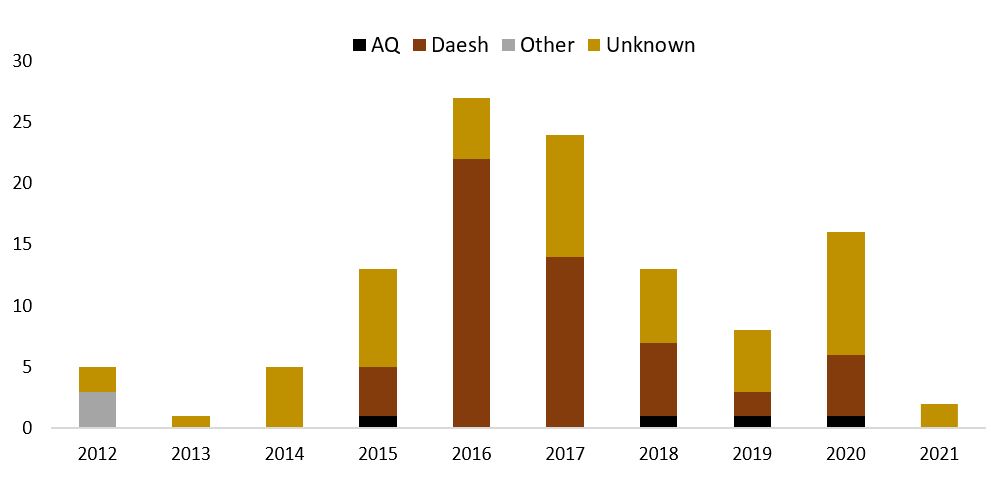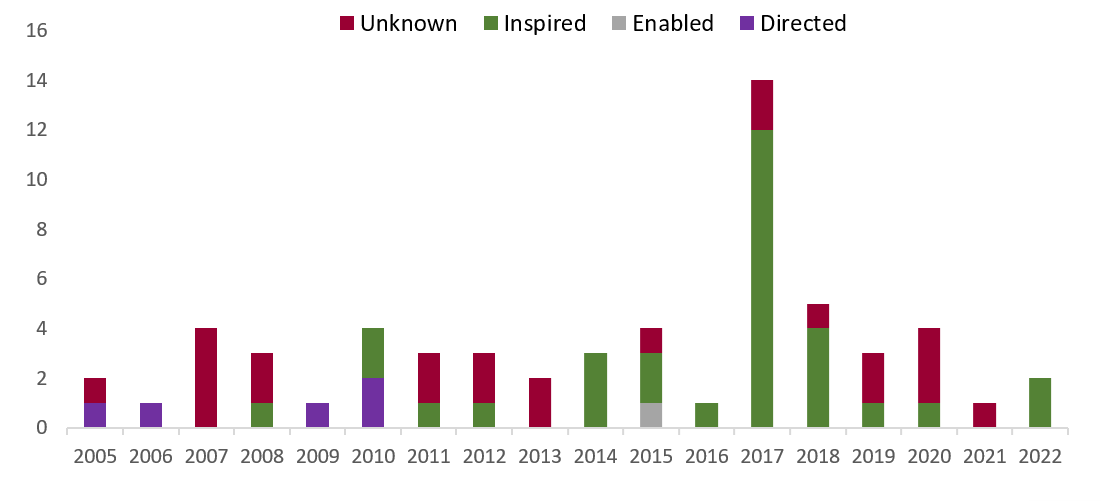What is Islamist Terrorism?
-
Islamist Terrorism1 can be described as terrorist violence motivated by a political ideology seeking the imposition of Sharia Law and the establishment of an Islamic Caliphate. While Islamist terrorism takes many forms, the principle threat to the UK comes from Salafi-Jihadists.
Headline Assessment
-
Over the last decade, the threat to the UK from Islamist terrorism has increased and diversified, principally driven by developments overseas and the emergence of Daesh.
-
While concerted counter-terrorism pressure from the West has reduced the threat from attacks directed and enabled by Islamist terrorist groups overseas, a threat will remain as long as al-Qa’ida (AQ) and Daesh maintain the intent to attack the West.
-
It is likely that Daesh continues to radicalise and inspire individuals in the UK to terrorist violence.
What is meant by Islamist Terrorism?
Whilst deemed a controversial phrase, as it is perceived by some Muslims to tarnish their religion, the use of the term Islamist (and Islamism) has a long accepted definition amongst scholars of Islamic thought, even in the Muslim world. It refers to a political ideology, as opposed to a religious belief, that seeks the imposition of Sharia Law and the establishment of ‘Khilafah’ or an Islamic Caliphate. While some Islamist groups do not advocate violence in furtherance of these aims, others do. It is the latter who choose to adopt terrorist violence in pursuit of their ideology to which Islamist terrorism refers.

While Islamist terrorism takes many forms, with ideologies based on interpretations of various schools of Islamic thought, the principal threat to the UK comes from Salafi-Jihadists. This represents a tiny minority of those who adhere to the precepts of Islam.

Origins of Islamist Terrorism
Islamist political ideology has its roots in the 20th century with influential ideologues such as Maulana Maududi (1903-1979), Hassan al-Banna (1906-1949) and Sayyid Qutb (1906-1966). Al-Banna, with his ideas of regenerating society through Islam, founded the Muslim Brotherhood in Egypt in the late 1920s. At the same time, Maududi, in what was then British India, was advocating an Islamic state covering the sub-continent living under Sharia. He went on to establish the Jamaat-e-Islami movement in 1941.
Thirty years later, Muslim Brotherhood member Sayyid Qutb developed al-Banna’s and Maududi’s ideas into a violent political theology that called all true Muslims to offensive jihad, or holy war against what Qutb saw as a corrupt and degenerate West (in particular the United States) and their ‘puppets’ in the Arab world. The combined influences of Qutb and Maududi spawned a number of Islamist movements that would emerge over the coming decades. Notable amongst these are Salafi-Jihadi terrorist groups al-Qaida (AQ), formed in late 1990s in Afghanistan by Usama bin-Laden and Ayman al-Zawahiri, as well as the more recent so-called Islamic State in Iraq and the Levant (Daesh).
What is the threat from overseas Islamist groups?
Over the last decade, the threat to the UK from Islamist terrorism has increased and diversified, principally driven by developments overseas, notably in Syria and Iraq. The permissive environment there, as in other conflict zones, has allowed terrorist groups like Daesh to grow and plan attacks against the West. The availability of a large pool of individuals who have travelled from around the world (including Europe) to engage in the conflict in Syria and Iraq has heightened this threat.
During this period, the number of attacks by Islamist terrorists (predominately Daesh) in the West peaked in 2016 (see Figure 3) when Daesh-controlled territory in Syria and Iraq was also at its height. Europe in particular experienced a wave of attacks either carried out or inspired by Daesh. While concerted counter-terrorism pressure from the West has reduced the threat from attacks directed and enabled by Islamist terrorist groups overseas, a threat will remain as long as AQ and Daesh maintain the intent to attack the West.
Figure 3 - Islamist terrorist attacks in Europe and North America 2012-2021

How does the threat manifest in the UK?
There has not been an Islamist terrorist attack in the UK directed from a group overseas since the London 7/7 attacks on transport in 2005. Of the four attackers who were all British residents, two are assessed to have attended terrorist training camps in Pakistan and likely received some direction by elements of AQ. It was also around this time that several other AQ plots were disrupted including the 2006 plot to target several transatlantic aircraft flying from the UK with suicide bombers. Since then, as AQ has focused on regional conflicts overseas (e.g. Afghanistan, Somalia, Syria, Yemen etc.), the group’s direct threat to the UK has diminished.
However, the conflict in Syria and Iraq that gave rise to Daesh has seen a marked increase in attack plotting by Self-Initiated Terrorists (S-ITs). Between 2005 and 2013 the majority of Islamist plots in the UK were directed or enabled by AQ. From 2014 onwards nearly all Islamist terrorist attacks were planned and carried out by mostly British born S-ITs inspired by Daesh ideology (see Fig 4).
Figure 4 - Islamist terrorist attack and plots in the UK 2005-2022

By making effective use of social media and modern communication methods to publicise and glamorise their acts, it is likely that Daesh continues to radicalise and inspire individuals in the UK to terrorist violence. Once inspired, an individual can conduct a terrorist attack without any prior signs of radicalisation.
Probability and Likelihood in Intelligence assessments
When describing threats in intelligence assessments, Counter Terrorism Policing utilises the Probabilistic Yardstick.
The Probabilistic Yardstick is a tool created by the Professional Head of Intelligence Analysis (PHIA), in the UK government, to standardise the way in which we describe probability in intelligence assessments. For example, if we use the term ‘likely’ what we mean is ‘a 55-75% chance’.
Use the scale below as a reference when reading ProtectUK Insights.

1 His Majesty’s Government (HMG) do not currently provide a definition for Islamist Terrorism

